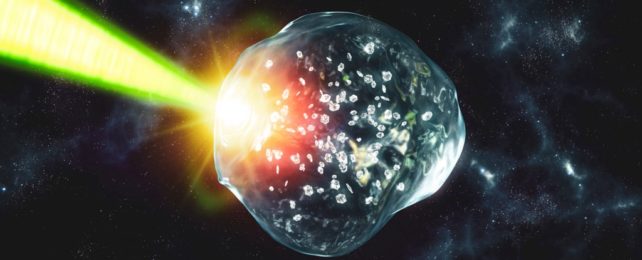Scientists on Friday speculated that diamond rain may be falling on planets throughout the universe after simulating the odd precipitation thought to originate deep inside Uranus and Neptune using everyday plastic.
Scientists had previously postulated that thousands of kilometers beneath the surface of the ice giants, under conditions of great pressure and temperature, carbon and hydrogen are transformed into solid diamonds.
Now, new research, published in Science Advances, added oxygen to the mix and discovered that “diamond rain” may occur more frequently than previously believed.
Since ice giants like Neptune and Uranus are believed to be the most prevalent type of planet outside of our Solar System, diamond rain may be present throughout the entire Universe.
The Difference In Rainfall
One of the study’s authors, Dominik Kraus, a physicist at the German HZDR research facility, noted that diamond precipitation was very dissimilar from rain on Earth. The diamonds are thought to originate in a “hot, dense liquid” beneath the planets’ surfaces, where they gradually descend to the rocky, potentially Earth-sized cores more than 10,000 kilometers (6,200 miles) below.
According to Kraus, the diamonds that have fallen there may have formed huge layers that extend “hundreds of kilometers or possibly more.” He claimed that although these diamonds might not be polished and cut like “a magnificent gem on a ring,” they were created by the same forces that exist on Earth.
What Is The Scientists’ Observation?
The research team identified the essential ratio of carbon, hydrogen, and oxygen with the aim of replicating the process.Kraus stated that even though the researchers used PET plastic that was extremely clean, “the experiment should work with Coca-Cola bottles” in theory.
At the SLAC National Accelerator Laboratory in California, the scientists next used a strong optical laser to cut through the plastic. They were able to observe the formation of nanodiamonds—tiny diamonds too small to be seen with the naked eye—using “very, very short X-ray flashes of tremendous brilliance,” according to Kraus.
He continued, “It’s really easier for those diamonds to form because the oxygen that is present in significant quantities on those planets really helps suck away the hydrogen atoms from the carbon.
Conclusion
The experiment might reveal a new method for creating nanodiamonds, which have a growing number of uses, such as drug delivery, medical sensors, minimally invasive surgery, and quantum electronics.
According to SLAC researcher and study co-author Benjamin Ofori-Okai, “the way nanodiamonds are now generated is by taking a pile of carbon or diamond and blowing it up using explosives.
“He continued, “Laser synthesis may provide a cleaner and easier to manage approach to generate nanodiamonds. Since little is known about Uranus and Neptune, the two most distant planets in our Solar System, the diamond rain research is still purely theoretical.
